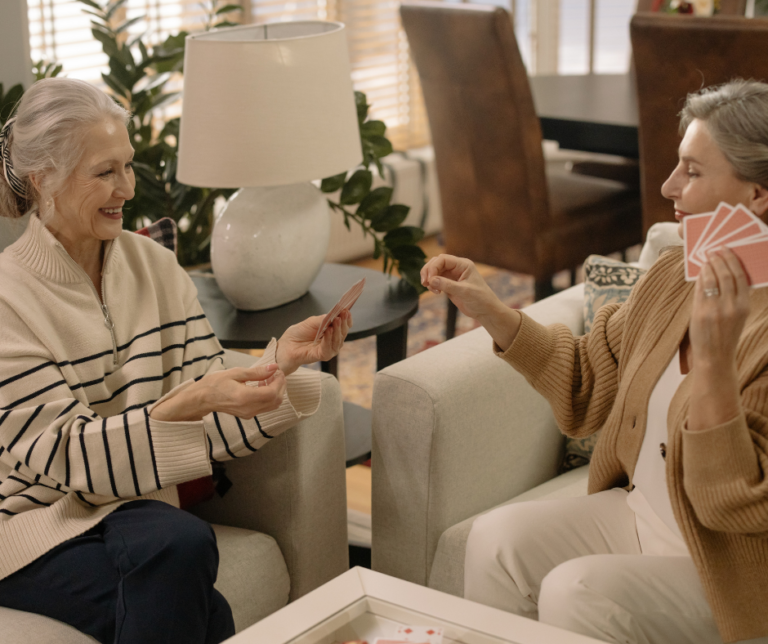Best Activities for Dementia: Staying Active and Engaged

Keeping someone with dementia engaged in meaningful activities is essential for their cognitive health, emotional well-being, and overall quality of life. In this blog, we’ll explore why engagement matters and share some of the best activities for dementia to help your loved one stay active and engaged. Plus, I’ll link to some of the activities for dementia that have been successful with my clients.
Benefits of Activity
- Promotes Cognitive Stimulation
- Engaging in meaningful activities can help maintain cognitive function and slow decline
- Activities that include creativity, problem-solving, or memory recall can be beneficial
- Supports Physical Health
- Any movement is better than no movement for delivering more oxygen to brain cells
- Chair exercises, walking and even stretching improves mobility, strength and circulation
- Encourages Socialization
- One-on-one and group activities promote socialization
- Conversation during activities help avoid isolation and loneliness
- Boosts Emotional Well-Being
- Familiar activities can evoke positive memories which can provide comfort
- Completing activities contributes to a sense of purpose, which in turn improves self-esteem
- Reduces Agitation
- Enjoyed activities can be a great tool for redirection and distraction, helping calm restlessness
- Boredom can be associated with anxiety and agitation so staying busy can prevent this
Selecting the Right Activity
It’s important to match activities to the person’s current abilities and interests. Selecting the best activities for dementia that align with their current skill level ensure they can participate successfully without feeling overwhelmed. Just as you would feel frustrated if someone asked you to read sheet music when you have never learned this before, someone living with dementia can also feel frustrated if they don’t understand what to do.
You also want to consider activities that they will enjoy. One is more likely to participate when it’s something they find joy in. For example, someone who loved gardening may enjoy watering plants or flower arranging. And someone who enjoyed cooking or baking may enjoy stirring ingredients in a bowl. Tailor activities to them specifically.
Encouraging Participation
Engaging someone with dementia in activities isn’t just about keeping them busy – it’s about creating meaningful moments to help them stay active and engaged. Start by setting the right tone. Your approach can make all the difference. If you present an activity with enthusiasm and kindness, the person is more likely to engage. Avoid making the activity feel like a task and focus on gentle encouragement rather than insisting that they participate.
Make it social and interactive by including yourself or others. Offer simple choices, “Would you like to listen to music or look at photos?” Allow them to participate at their comfort level, don’t rush – and remember there is no right or wrong way. Create a calm environment with minimal distractions so they can focus on the task at hand. If they become tired, break the sessions up into smaller amounts of time.
Always celebrate small successes and recognize their efforts. Smile, laugh and say, “You’re doing a great job!”. Use nonverbal encouragement like clapping or giving a thumbs up to reinforce their success. Remember to focus on the fun, not the final outcome. Keeping the activities lighthearted, stress-free, and centered on enjoyment, can create positive experiences.
My Recommended Activities for Dementia
While there are many choices in finding the best activities for dementia, I want to share some of my favorites. Try an activity with your loved one and if they don’t seem to enjoy, try another. The possibilities are endless. I’ve included direct links to some of the activities listed below.
1. Early-stage (mild cognitive impairment, mostly independent)
Cognitive activity
- word search CLICK HERE
- card games CLICK HERE
- crafts CLICK HERE
- jigsaw puzzles CLICK HERE
- light cooking
- reading short stories
- interactive touchscreen games
Physical activity
- walking
- yoga
- tai chi
- dancing
- swimming
- gardening
2. Mid-stage (increased memory loss, some physical and cognitive changes)
Cognitive activity
- matching patterns CLICK HERE
- matching colors CLICK HERE
- painting or coloring CLICK HERE
- jigsaw puzzles (12-36 pieces) CLICK HERE
- clapping to a beat of music
- folding laundry
- stirring ingredients or decorating cookies
Physical activity
- guided walks
- chair exercises
- balloon volleyball
- dancing with support
- arm and leg stretch
- assisted stationary bike
3. Late-stage (often requires full assistance, limited mobility, significant cognitive decline)
Cognitive activity
- picture books with large, colorful images CLICK HERE
- sensory stimulating plush animal CLICK HERE
- listen to familiar songs
- holding hands
- aromatherapy
- hand massage
- reading to your loved one
- passive range of motion exercises
- gentle stretching
- squeezing soft items
- hand over hand activities such as clapping to music
- rocking in a chair
- swaying while listening to music
Conclusion
Engaging your loved one in meaningful activities isn’t just about filling time – it’s about enhancing their quality of life, preserving cognitive function and creating moments of joy. Whether through physical movement, social interaction, or cognitive stimulation, the right activities can provide a sense of purpose and connection. I hope you found these best activities for dementia helpful! In my customized care plans, I always incorporate recommendations for cognitive, social and physical activities to help support overall well-being. If you need guidance on creating a personalized approach for your loved one that includes the best activities for dementia, I’m here to help.
Follow Dementia Nurse Andrea
for tips, tools, and expert insights to support your dementia care journey - free every day!
